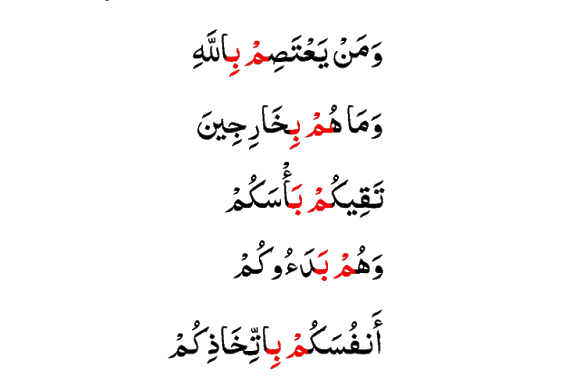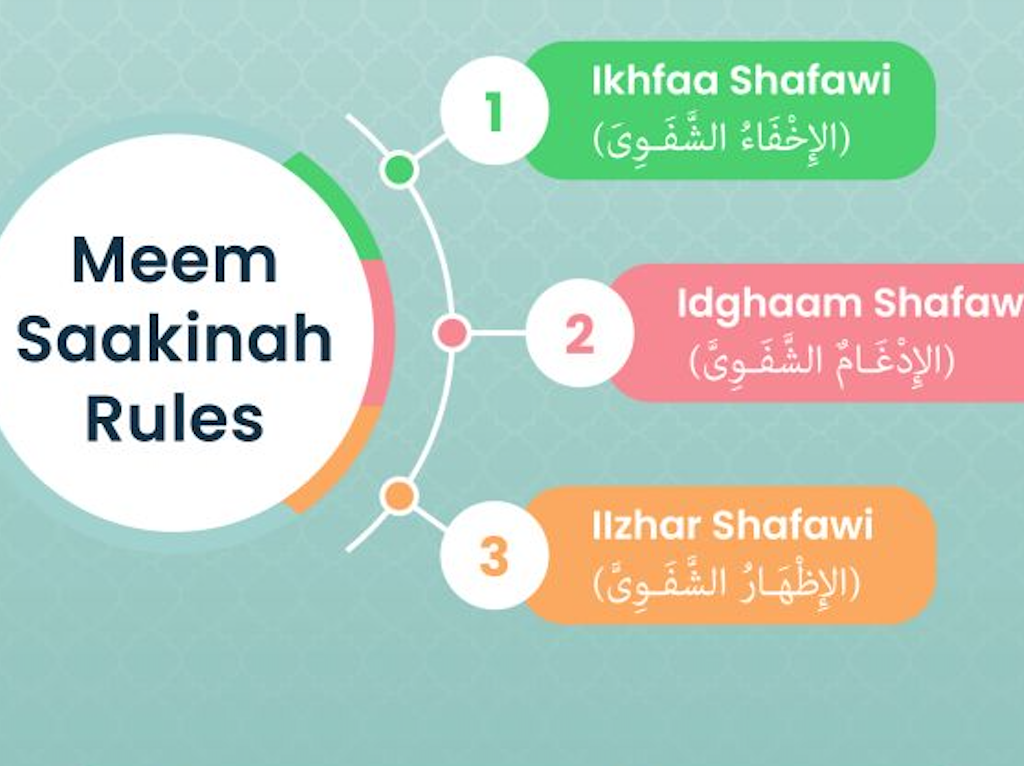To recite the Quran with precision and in accordance with the principles of tajweed, a thorough understanding of the rules of Meem Sakinaah is crucial. Moreover, the Prophet Muhammad (peace be upon him) declared, “Those proficient with the Qur’an will be among the noble and righteous scribes (the angels), and those who read it with difficulty will still receive double rewards” (Ibn Majah). Therefore, reciting the Quran correctly is not only fulfilling a religious duty but also a means of attaining spiritual rewards.
Ibn Al-Jazari, in his renowned poem on the rules of Tajweed, emphasized the obligatory nature of applying Tajweed, stating that those who do not recite the Quran correctly are committing a sin.
Defining Meem Sakinaah
Meem Sakinaah:
Refers to a Meem (م) with a Sukoon (a diacritic indicating the absence of a vowel) on it. This Meem Saakin can occur in the middle or at the end of any word.
Meem Sakinaah examples:

What are the Rules of Meem Sakinaah?
- Ikhfaa Shafawi
- Idgham Shafawi
- Izhar Shafawi

Ikhfaa Shafawi rule
Linguistic definition:Hide
Applied definition:
If the Meem Sakinaah is followed by letter ب ,the reader should hide the Meem and pronounce it with Ghunnah. This should be in Two words.
The pronunciation of the non-voweled letter stripped of any “Shaddah”, characterized as between clear and merged, with the ghunnah remaining of the first letter, which in this case the .
Method of Pronunciation:If the Meem Saakin is followed by “ب”, the reader should hide the Meem and pronounce it along with “ب” but with ġunnah. It’s called Shafawi because the Meem is pronounced from the lips. The word Shafawi refers to lips in Arabic.
It’s letter: The letter of Ikhfaa only letter ب
Examples of Ikhfa Shawai:

Idgham Shafawi Rule
Linguistic definition: Insertion, Merging
Applied definition: The meeting of non-voweled letter with a voweled letter, so that the two letters become one emphasized letter of the second type.
Method of Pronunciation:
If the Meem Saakin is followed by “م,” then it merges with the next Meem and is pronounced with Ghunnah. The Idgham occurs in Two seperate words.
The secodn Meem should have a Shadah.
Note:Furthermore, this Idgham is also referred to as Idgham Mithlain Sagheer. The term “Mithlain” emphasizes the similarity between the two letters, one silent and the other with Harakah, as they share the same Makhraj and Sifah. Additionally, the word “Sagheer” highlights their distinct states, with the first letter remaining unvoweled while the latter carries a vowel.
It’s letter: The letter of Idgam only letter م
Examples of Idgham Shafawi:

Izhaar Shafawi Rule
Linguistic definition: Clear or obvious
Applied definition:Pronouncing every letter from it’s articulation point without a ghunnah on the clear letter.
Method of Pronunciation: If the Meem Saakinah is followed by any later other than “م-ب” it has to be prononuced clearly without Ghunnah
It’s letter: The letter of Izhar any later other than “م-ب“
Examples of Izhar Shafawi:

In conclusion:
Understanding Meem Saakinah is vital for mastering Arabic grammar, particularly in the context of Quranic recitation. Additionally, it plays a pivotal role in enhancing one’s linguistic proficiency. By understanding Ikhfaa, Idghaam, and Izhar Shafawi, learners can easily handle Meem Saakinah cases.

